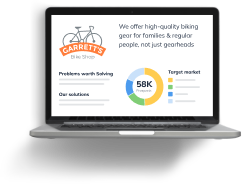How to Write a Business Plan
Noah Parsons | Jun 23, 2023
Writing a business plan doesn’t have to be complicated. The more you know about what goes into your plan, the easier it will be to write.
In this step-by-step guide, you’ll learn how to write a strong business plan that’s detailed enough to impress bankers and potential investors while helping you start, run, and grow a successful business.
Follow these steps to write a business plan
Follow these eleven simple steps and download one of our free business plan templates to make writing your business plan quick and easy.
A one-page business plan is a succinct, high-level overview of your business concept, key objectives, and strategy for success. It serves as a roadmap that outlines the essential details of your business and its operations in a clear and concise format.
Common components of writing a business plan include a problem and solution statement, an outline of your business model, target market, competitive advantage, a breakdown of your team, and a financial summary.
The one-page plan is where you will outline all of your important business details with a brief and focused document that’s incredibly easy to update and expand. Despite its brevity, a one-page business plan can be a powerful tool that provides a clear vision of what you aim to achieve and how you plan to do it. It’s not only a foundational document for your business operations, but also a persuasive tool when pitching to investors or potential partners.
You may even find that it’s all you need to run your business.
The executive summary is the first, and possibly only, thing investors, employees and anyone else will read. It should provide an overview of your business operations, strategy, and goals within one or two pages. While it does come first in your plan it should be the last thing you complete—after you have written the other parts of your business plan.
Despite its brevity, you will still want to include several important pieces of information when writing your business plan executive summary. These include the unique product or service your business offers, the market it targets, and why it holds a competitive advantage. It establishes both high-level facts like the company’s vision and mission statement, as well as previewing technical details like an overview of financial projections or funding request.
Is there actually a need for what you plan to offer?
Whether you’re selling products, services or both, this section is where you will detail not only what you provide, but also how your offerings solve problems your customers are dealing with, the value you provide and how your solution sets you apart from competitors. It is also where you can show you have a solid grasp of logistical details like pricing and distribution.
To truly showcase the value of your products and services, you need to craft a compelling narrative around your offerings. How will your product or service transform your customer’s life or work? This narrative will draw in your audience, whether they’re potential customers or investors.
Above all, it is the area when writing your business plan to really showcase the value of your products and/or services.
This is likely to be one of the most time-intensive steps in writing your business plan. It requires developing a comprehensive assessment of the environment you plan to operate in. Especially if you’re writing a business plan to secure a loan or investment, you will need to show that you understand the dynamics and trends in the market.
Conducting a marketing analysis involves segmenting your market based on demographic and psychographic information. These are attributes like their age, income level, interests and habits. Your target market is the specific group of people who are most likely to become your customers.
The goal of this section is for you to paint a clear picture of who your ideal customers are, determine if the market is viable for your business, and back up your claims with supporting information. If you were to present this part of your plan to an investor, they would hopefully have no questions about who your business will be serving.
Part of defining your opportunity is determining what your competitive advantage may be. To do this effectively you need to get to know your competitors just as well as your target customers. Every business will have competition, if you don’t then you’re either in a very young industry or there’s a good reason no one is pursuing this specific venture.
To succeed, you want to be sure you know who your competitors are, how they operate, necessary financial benchmarks, and how you’re business will be positioned. Remember, this will likely be something you revisit and update in the future as the competitve landscape shifts and changes.
The marketing and sales plan includes how you will position your product or service in the market, the marketing channels and messaging you will use, and your sales tactics. This section should give a clear picture of what your growth trajectory looks like, the milestones you intend to achieve, and how you plan to measure success.
Your marketing strategy should align strategic goals with concrete marketing activities that aim to engage your target market and persuade them to purchase your product or service.
The sales plan should clearly estimate how much you aim to sell, and provide actionable steps to achieve those goals.
Together, these specific plans paint a picture of how you will not just connect with your target audience but how you will turn them into paying customers.
The operations section describes the necessary requirements for your business to run smoothly. This includes elements such as inventory, supply chains, equipment and technology, distribution, and manufacturing. In short, this section is where you talk about how your business works and what day-to-day operations look like.
Operations do not cover your business model and organizational structure. Instead, your operations and distribution are tied strictly to execution and help further fill out how you will achieve your goals and objectives.
For businesses without a physical product, you can use this section to describe the technology you’ll leverage, what goes into your service, who you will partner with, and any other factors that keep your services running.
A good milestone clearly lays out the parameters of the task at hand and sets expectations for its execution. You’ll want to include a description of the task, a proposed due date, who is responsible, and eventually a budget that’s attached. You don’t need extensive project planning in this section, just key milestones that you want to hit and when you plan to hit them.
You should also discuss key metrics, which are the numbers you will track to determine your success. Some common data points worth tracking include conversion rates, customer acquisition costs, profit, etc.
It’s perfectly fine to start small and grow the number of metrics you are tracking. You also may find that some metrics simply aren’t relevant to your business and can narrow down what you’re tracking over time.
This is a fairly short, but important, section. Investors look for great teams in addition to great ideas—and this is your chance to prove that you have both.
Include brief bios that highlight the relevant experiences of each key team member. It’s important here to make the case for why the team is the right team to turn an idea into a reality. Do they have the right industry experience and background? Have members of the team had entrepreneurial successes before?
Your company overview should also include a summary of your company’s current business structure. The most common business structures include:
Be sure to provide a review of how the business is owned as well. Does each business partner own an equal portion of the business? How is ownership divided? Potential lenders and investors will want to know the structure of the business before they will consider a loan or investment.
Many business owners feel intimidated by the financial component of writing their business plan. But it doesn’t require a business degree or advanced math skills to create well-structured, accurate financial statements.
Creating a comprehensive financial plan starts with a sales forecast, where you estimate the sales expected over a given period. Just as important is an expense budget, where you project future costs such as personnel costs, equipment, marketing expenses, and taxes.
A strong business plan will include assumptions about the future and potential risks that could impact the financial plan. Including those will be especially important if you’re writing a business plan to pursue a loan or other investment.
Including an appendix in your business plan can significantly enhance the credibility of your plan by showing readers that you’ve thoroughly considered the details of your business idea and are backing your ideas up with solid data.
Just remember that the information in the appendix is meant to be supplementary. Your business plan should stand on its own, even if the reader skips this section.
Why do you need a business plan?
Even after reviewing these steps you may be wondering, “Why should I spend my time making a business plan?” Here are the top reasons why you should invest in planning:
Businesses that plan grow 30% faster.
A surprising amount of research has been done on business planning and has shown that companies that take the time to write a plan and review it regularly grow 30% faster than those businesses that don’t plan. Not only do these companies grow faster, but they perform better and are less likely to fail in the long run.
Lenders and investors need business plans
If you’re growing your business and plan on getting a business loan or raising money from investors, you’ll need a business plan. Most lenders and investors will ask for a plan, but even if they don’t want to see the actual document, they will ask you questions that only a solid business plan will be able to answer.
Business plans reduce risk
Starting and running a business is always risky. Instead of flying by the seat of your pants, you can use a plan to forecast potential cash flow issues and get ahead of any potential roadblocks so you aren’t caught off guard. A business plan will help you reduce your risk and help you navigate the future.
Business planning helps you make smart spending decisions
Before you make a big spending decision for your business, you need to know the potential impacts on your finances. With a business plan in place, you can easily explore different scenarios and see what impacts a new hire or an expansion to a second location will have on your business.
Need more reasons for why you need a business plan? Read our full list of reasons why having a business plan is important for small businesses.
Start writing your business plan
Whether you’re writing a plan to explore a new business idea, establishing steps to start a business, looking to raise money from investors, seeking a loan, or just trying to run your business better—a solid business plan will help get you there.
Business planning is a continuous process that can help you validate your idea, set goals, manage, and successfully pitch your business. One of the most helpful things you can do to build a successful business is to jump in and start planning.
For detailed guidance on writing specific sections of your business plan, check out the links above for additional resources.
For more on business planning, including tips for writing a great plan, what options are available, and even specific industry guides—check out our full Business Planning Guide.
Business Plan templates and tools
Kickstart your business plan writing with one of our free business plan templates or recommended tools.










